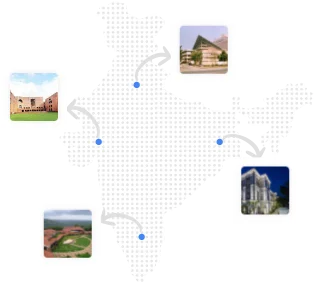Nepal
Nepal, formerly known as the Federal Democratic Republic of Nepal, this South Asian nation is landlocked. It is mostly in the Himalayas, but it also includes parts of the Indo-Gangetic Plain. It borders China's Tibet Autonomous Region to the north, India to the south, east, and west, and the Siliguri Corridor narrowly separates it from Bangladesh and Bhutan. The Indian state of Sikkim separates it from Bhutan. Nepal has a variety of landscapes, including fertile plains, subalpine forested hills, eight of the ten tallest mountains in the world, including Mount Everest, the world's highest point. Nepal is a multi-ethnic, multi-lingual, multi-strict and multi-social state, with Nepali as the authority language. The nation's capital and largest city is Kathmandu.
The name "Nepal" first appears in texts from the Vedic period of the Indian subcontinent. During this time, Hinduism, the country's predominant religion, was founded in ancient Nepal. The Buddha of Buddhism, Gautama Buddha, was born in Lumbini in the south of Nepal in the middle of the first millennium BC. Tibet's culture was intertwined with parts of northern Nepal. The halfway found Kathmandu Valley is interlaced with the way of life of Indo-Aryans, and was the seat of the prosperous Newar alliance known as Nepal Mandala. The traders in the valley ruled the Himalayan portion of the ancient Silk Road. Unique traditional art and architecture were created in the cosmopolitan region. Nepal was unified by the Gorkha Kingdom by the 18th century. The Shah dynasty established the Kingdom of Nepal and later joined forces with the Rana dynasty of premiers of the British Empire. The nation served as a buffer state between British India and Imperial China but was never colonized. Parliamentary democracy was established in 1951, but the Nepalese monarchy ended it twice—in 1960 and 2005. In 2008, the secular republic of Nepal was established as a result of the 1990s and early 2000s Nepalese Civil War, which brought an end to the world's last Hindu monarchy.
Nepal is recognized as a secular federal parliamentary republic with seven provinces in its 2015 Constitution. Nepal joined the United Nations in 1955, and in 1950 and 1960, friendship agreements were made with China and India. Nepal has the long-lasting secretariat of the South Asian Relationship for Local Participation (SAARC), of which it is an establishing part. Additionally, Nepal is a member of the Bay of Bengal Initiative and the Non-Aligned Movement. The Nepalese armed forces rank fifth in South Asia in terms of size; and are well-known for their Gurkha heritage, particularly during the two world wars, and for contributing significantly to UN peacekeeping efforts.
Why to study in Nepal
Nepal seems like a great place to study for MBBS students who want to be medical representatives. Nepal offers hospitable opportunities to both national and international students, and it is the safest and friendliest location for international students seeking MBBS admission.
Bachelor of Medicine and Bachelor of Surgery are professional programs that last five and a half years in Nepalese medical schools. In order to contribute to the medical and health industry, these colleges aim to provide quality-driven courses, practical training, and extracurricular activities. The Medical Council of Nepal and the respective colleges' administrative departments oversee this program.
Nepal is the best place to study for students who are interested in the basic and internal body, its functioning, and diagnosing diseases.
Top Universities of Nepal
1. Tribhuvan University
Tribhuvan College is a state funded college situated in Kirtipur, Kathmandu. The oldest university in Nepal is TU, which was established in 1959. It is the 12th largest university in the world in terms of enrollment. The college has over 1,000 undergraduate and 500 graduate programs in many different fields.
2. Kathmandu University
Nepal's Kathmandu University is a public, independent institution. It is the third oldest university in Nepal and can be found in Dhulikhel, which is in the Kavrepalanchok District and is about 30 kilometers to the east of Kathmandu. With the motto "Quality Education for Leadership," it was established in 1991.
3. Pokhara University
Pokhara College was laid out in 1997 and is Nepal's fifth college. Pokhara, in the Kaski District of the Gandaki Province, is home to its main office. Alongside Purbanchal College, PU was shaped as a component of an administration drive to further develop admittance to advanced education.
4. Lumbini Buddhist University
Pokhara College was laid out in 1997 and is Nepal's fifth college. Pokhara, in the Kaski District of the Gandaki Province, is home to its main office. Alongside Purbanchal College, PU was shaped as a component of an administration drive to further develop admittance to advanced education.
5. Far-Western University
Far Western College is a college in Nepal, situated in Mahendranagar, Kanchanpur. The Government of Nepal established it in August 2010 through an Act of the Constituent Assembly. After the university officials were appointed, it went into effect in 2011.
Places to Visit while Travelling Nepal
1. Pashupatinath Temple
Pashupathinath Temple, on the banks of the divine Baramati River, is one of Nepal's most sacred and ancient attractions. It was built in the 5th century and is a UNESCO World Heritage Site.
The temple complex has several Shiva lingams, a Nandi Statue, and temples for other Hindu and Buddhist deities, all of which provide an intriguing mix of spiritual, religious, and cultural experiences. Hindu devotees travel from all over the world to the complex, which is a living cultural heritage site.
2. Nagarkot
Nagarkot is a peaceful hill station at an elevation of 7000 feet, and it is just 28 kilometers from the Kathmandu International Airport. Before it became a popular international tourist destination, it was a summer retreat for royal families. Out of Nepal's 13 Himalayan ranges, the area offers stunning views of Mount Everest and the Kathmandu Valley.
3. Chandragiri
Chandragiri Hills, famous for their cable car ride, not only offer stunning views of the Himalayan ranges but also a chance to feel refreshed in a new environment.
One must either drive 11 kilometers, take a Gondola ride, or roughly walk to the top of the hill. The stunning trails take three hours, but the views from the top and the atmosphere are well worth the effort and last forever.
4. Janaki Temple
Janaki Temple is a Hindu and Koiri Nepali architectural masterpiece dedicated to Goddess Sita and is in the Mithila district of Nepal. It is the same location where Sita was born and married God Rama, according to Hindu mythology.
It is one of Nepal's most well-known religious destinations, where devotees can offer prayers and seek the blessings of Hindu deity Rama and his wife Sita. The sanctuary is a lovely three-celebrated design and dazzles with its exterior, insides, and style.
5. The Boudhanath Stupa
The Boudhanath Stupa is one of the world's largest spherical stupas and features a stunning massive mandala. Buddhists visit it to perform the Kora ritual and seek God's blessings, making it one of their most sacred shrines.
In addition to housing the relics of Kassapa Buddha, the Stupa is a UNESCO World Heritage Site in Nepal. The complex also contains over fifty Tibetan gompas, which house Tibetan refugees.


